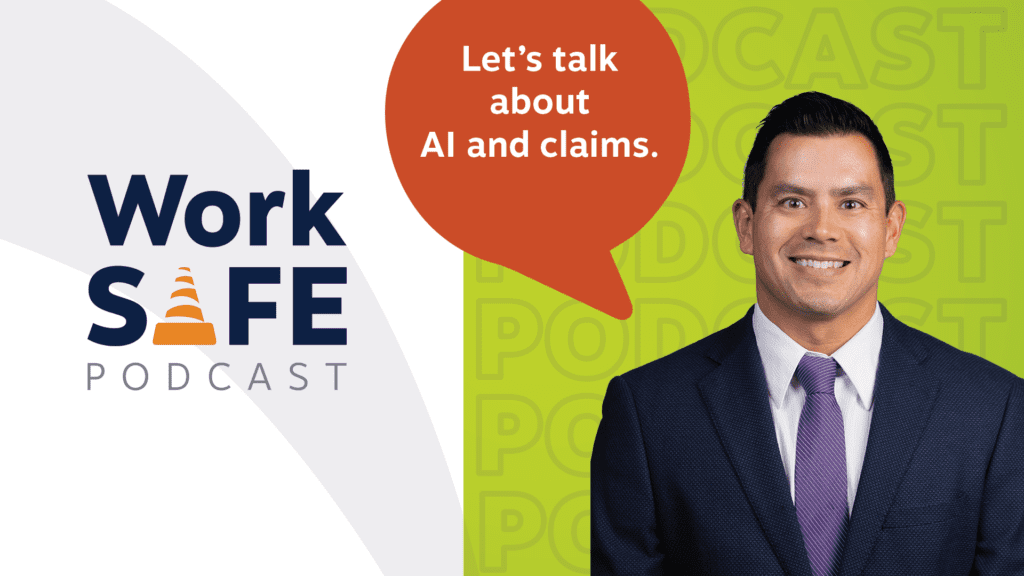On this episode of the WorkSAFE Podcast, we sit down with Mark Phillips, Director of Claims at MEM, to discuss how artificial intelligence (AI) is transforming the work comp claims process.
Organizations are always looking for ways to be more efficient. While some of those efficiencies are gained through changing standard operating procedures, others come from technological advancements.
Artificial intelligence (AI) is gaining speed. Many workplaces are now using it to automate and assist with various tasks. Leveraging AI can help companies reduce costs while improving outcomes.

Listen to this episode of the WorkSAFE Podcast, or read the show notes below.
How artificial intelligence changes the claim process
“Traditionally, the claims process within workers compensation has been a static approach,” Phillips explained. First, an injured worker receives medical attention. A claims representative or adjuster will follow up by reviewing medical records, setting additional appointments, and keeping all parties up-to-date.
Using artificial intelligence (AI) allows for streamlining claims and creating efficiencies. More importantly, it doesn’t take over the process from claim professionals; it acts as a support system. “It’s not taking away any type of decision-making or strategy or critical thinking from our claim staff,” he highlighted. AI serves as a virtual assistant, diving deeper into tasks that take more time.
For example, it can summarize several pages of medical records or highlight inconsistencies in statements. As a result, claim professionals have more time to consult with internal experts, have important conversations with injured workers or policyholders, and create one-on-one connections.
Using developing technology as a tool
While AI is growing in popularity, it’s still a developing technology. “Something I think is really important for folks to understand as it relates to AI, especially in the claims process, is that it’s not a crystal ball, right?” Phillips shared. “It is a tool for our staff and claims professionals to use.”
He compares AI’s work to the way a GPS works on a mobile phone or in a vehicle. It provides a roadmap of the way ahead but may offer more than one route to your destination. An unexpected road closure or traffic jam may require a route change.
“It is ultimately up to the driver to pick which route fits them best,” he said. AI is a tool that’s still evolving; it’s not always 100% accurate. Claim professionals assess the information it provides critically and take all the records and documents they have into consideration before making a decision. This is especially true when considering red flags that may point to work comp fraud. “It’s really there to serve as directional guidance. But it is ultimately the claim professional’s or the adjuster’s role to pick the best path for the claims.”

The importance of efficiency in claims
For a claim professional handling dozens of claims in a single day, efficiency can be a challenge. It’s easy to get bogged down by hundreds of claim activities, or steps in the claim process, that need to be scheduled, documented, or shared with an agent or policyholder.
One of Phillips’s personal mantras is ‘no surprises’. “We don’t want any surprises for any of the parties involved in the claims process,” he explained. “AI allows us to have more time to keep everybody informed on the current status, as well as what they can expect down the road in the claims process.” AI efficiency creates more room for review, and also leads to important outcomes:
- A shorter claim cycle. There is less time between the opening of a claim and its closure.
- More accurate costs. When injured workers get the right care when they need it, less time is spent and money is spent on the wrong type of care.
- Lower litigation percentage. Litigation extends the time and cost of a claim. A more efficient claim process lets an injured worker know everyone cares about them and is working toward getting them back to work.
Predictive analysis: A new benefit on the horizon of artificial intelligence
AI allows users to process large amounts of data and get a broader view of a claim. This view allows trends in claim activity to be identified. Further, the information can be used to forecast what costs or exposures should be expected with certain types of claims. This insight allows claim professionals to deploy resources that may help mitigate the overall cost.
For instance, assigning an adjuster with experience in a particular industry or a nurse case manager to provide extra guidance on medical care. AI provides an estimate of the path a claim might follow – and also provides opportunities to intervene and change that outcome.

Artificial intelligence isn’t a replacement for training
While artificial intelligence is proving to be a powerful tool, Phillips emphasizes that it isn’t a replacement for onboarding and on-the-job training, especially for claims professionals. However, it can be a helpful tool for new adjusters joining a claim in the middle.
For instance, an injured worker currently off work misses a doctor’s appointment. AI flags this as a reason recovery time is delayed. An adjuster just coming into the case can see this highlighted, rather than studying documents and timelines to see what might have been missed and when.
“It helps take out the manual approach to that,” Phillips explained. “It allows the claim professional to look at a couple of different options, potentially talk with a peer about that or their manager or supervisor, and ultimately make the best decision for the claim.”
Always evolving: Artificial intelligence in the future
For Phillips, the goal of using AI is to close claims faster and with better results. Technology is constantly evolving. He highlights that the AI used may look different as soon as tomorrow, and will look different six months from now.
“I think we’re really at the forefront of the next evolution of AI, as we use it for insurance carriers and in the industry, and I’m excited to see where it’s headed,” Phillips said. “I think we’ll be talking more about this in the future, and I would not be surprised if it looks a little or a lot different than it does today.”